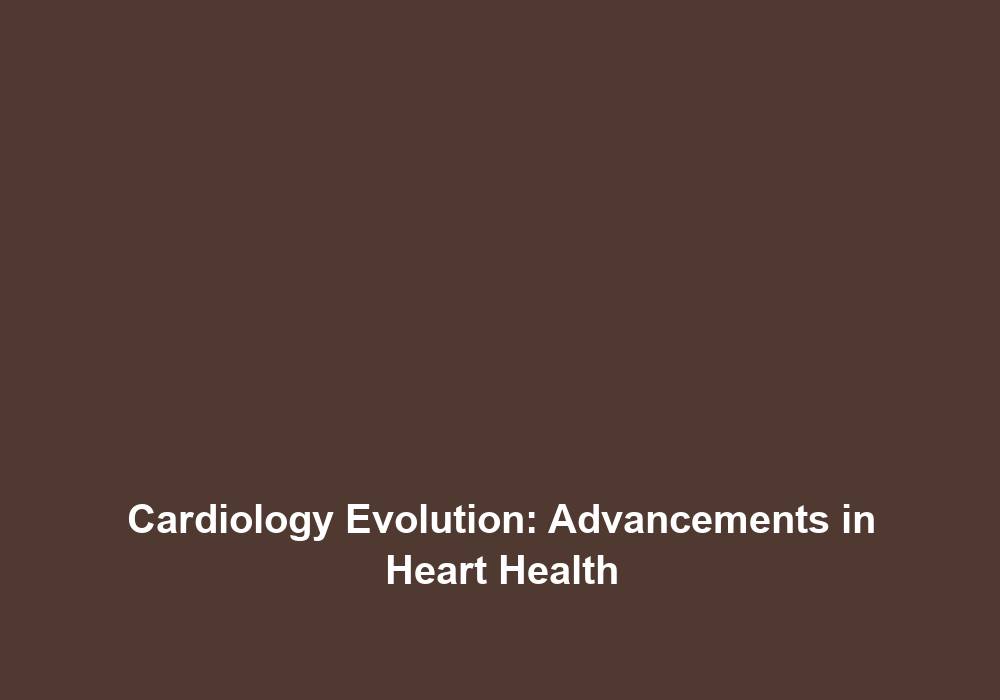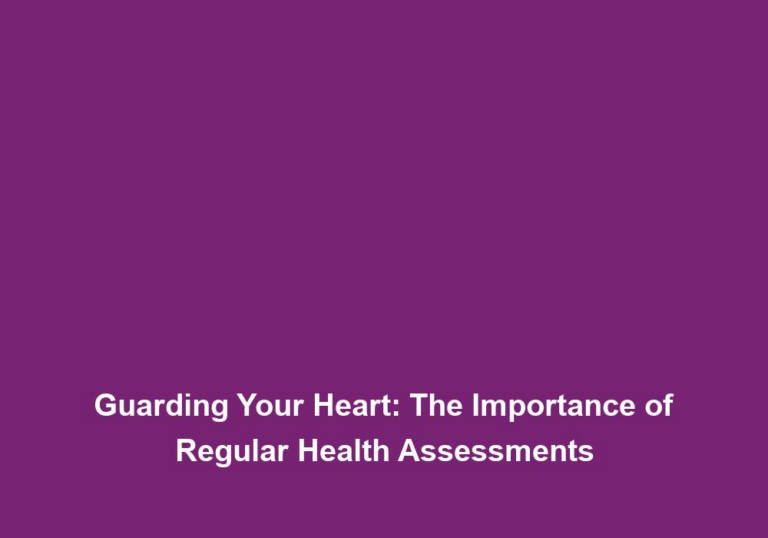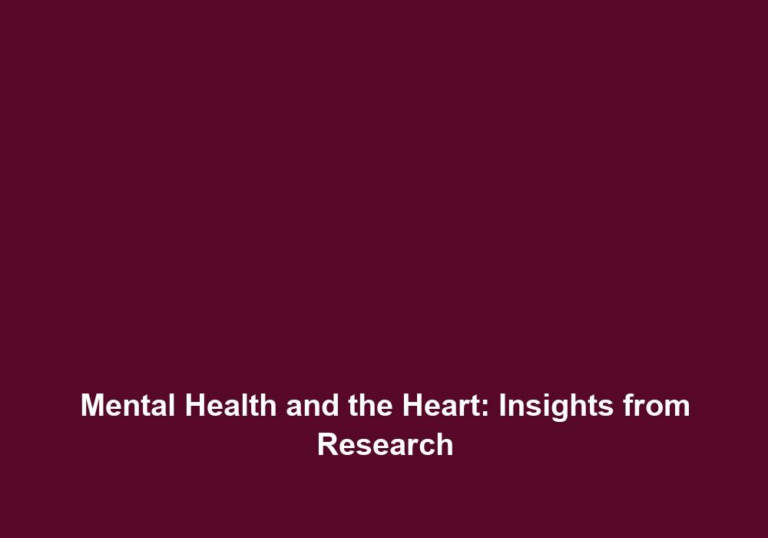Cardiology Evolution: Advancements in Heart Health
As the field of cardiology continues to evolve, we witness remarkable advancements in heart health that revolutionize the way we diagnose, treat, and prevent cardiovascular diseases. These advancements not only enhance patient care but also contribute to improving overall heart health on a global scale. In this article, we will explore some of the most significant breakthroughs in cardiology that have paved the way for a healthier future.
1. Diagnostic Innovations
Early and accurate diagnosis is crucial in managing heart conditions effectively. In recent years, cardiology has witnessed several remarkable advancements in diagnostic techniques, enabling healthcare professionals to identify cardiovascular diseases promptly and develop personalized treatment plans. Some notable diagnostic advancements include:
- Cardiac Imaging Techniques: Cutting-edge imaging technologies such as echocardiography, magnetic resonance imaging (MRI), and computed tomography (CT) scans provide detailed visualization of the heart’s structure and function, aiding in the diagnosis of various heart conditions. Echocardiography uses sound waves to create images of the heart, allowing doctors to assess heart valve function, detect abnormalities, and evaluate blood flow. MRI and CT scans provide detailed cross-sectional images of the heart, helping in the diagnosis of heart diseases such as coronary artery disease, heart defects, and tumors.
- Genetic Testing: Genetic testing plays a crucial role in identifying individuals at risk of inherited cardiovascular diseases. It helps in assessing the likelihood of developing certain conditions and enables early intervention and preventive measures. Genetic testing can identify specific gene mutations associated with heart diseases like hypertrophic cardiomyopathy, familial hypercholesterolemia, and long QT syndrome. By identifying these genetic markers, healthcare professionals can provide targeted interventions and lifestyle modifications to minimize the risk of developing cardiovascular diseases.
- Biomarkers: The discovery of specific biomarkers allows for the early detection and monitoring of cardiovascular diseases. Biomarker testing helps healthcare professionals assess the severity of the condition, predict treatment outcomes, and monitor the effectiveness of therapies. For example, elevated levels of troponin, a protein released during heart muscle damage, can indicate a heart attack. Measuring biomarkers like brain natriuretic peptide (BNP) helps in diagnosing heart failure and monitoring its progression.
Moreover, advancements in diagnostic innovations have also led to the development of portable devices, such as handheld ultrasound systems and smartphone-based electrocardiogram (ECG) monitors. These devices enable quick and convenient screening for heart conditions in remote or resource-limited settings, improving access to healthcare for underserved populations.
2. Interventional Procedures
Advancements in interventional cardiology have revolutionized the treatment of heart diseases, offering patients a quicker recovery time, reduced risk, and improved outcomes. Some notable interventional procedures include:
- Angioplasty: Angioplasty is a procedure used to open narrowed or blocked blood vessels. It involves inserting a tiny balloon into the affected artery, which is then inflated to widen the passageway and restore normal blood flow. In some cases, stents are also placed to hold the artery open. This minimally invasive procedure has significantly reduced the need for open-heart surgery in patients with coronary artery disease, improving the quality of life and reducing hospital stays.
- Transcatheter Aortic Valve Replacement (TAVR): TAVR is a minimally invasive procedure used to replace a diseased aortic valve. It involves threading a catheter through blood vessels to implant an artificial valve, eliminating the need for open-heart surgery. TAVR has revolutionized the treatment of aortic stenosis, a condition characterized by a narrowing of the aortic valve, particularly in elderly patients who may not be suitable candidates for traditional open-heart surgery.
- Electrophysiology Procedures: Electrophysiology procedures, such as ablation or implantation of pacemakers and defibrillators, help manage irregular heart rhythms and prevent life-threatening arrhythmias. Ablation techniques use heat or cold energy to destroy abnormal heart tissue causing arrhythmias, restoring the heart’s normal rhythm. Pacemakers and defibrillators are implanted devices that regulate heart rhythm and deliver electrical shocks to restore normal heart rhythm when needed. These interventions have significantly improved the quality of life for patients with arrhythmias and reduced the risk of sudden cardiac death.
Furthermore, advancements in interventional cardiology have also led to the emergence of hybrid procedures, combining surgical and minimally invasive techniques. These hybrid approaches allow for tailored treatment plans, ensuring optimal outcomes for patients with complex cardiovascular conditions.
3. Innovative Medications and Therapies
Significant advancements in medication and therapies have played a vital role in managing heart diseases and improving patient outcomes. Here are a few notable developments:
- Targeted Therapies: Advances in understanding the molecular mechanisms of various cardiovascular diseases have led to the development of targeted therapies. These medications specifically address the underlying causes of the condition, resulting in more effective treatments with fewer side effects. For example, targeted therapies for heart failure include angiotensin receptor-neprilysin inhibitors (ARNIs) and sodium-glucose cotransporter-2 (SGLT2) inhibitors, which have shown significant benefits in reducing hospitalizations and improving survival rates.
- Anticoagulants: The introduction of novel oral anticoagulants (NOACs) has transformed the management of conditions such as atrial fibrillation and deep vein thrombosis. These medications provide a safer and more convenient alternative to traditional blood thinners like warfarin. NOACs, such as apixaban and rivaroxaban, have shown comparable efficacy in preventing strokes and reducing the risk of bleeding complications.
- Cardiac Rehabilitation: Cardiac rehabilitation programs have been proven to enhance recovery and improve the long-term outcomes of patients who have experienced heart attacks or undergone cardiac procedures. These programs incorporate exercise, education, and counseling to promote heart health and reduce the risk of future cardiac events. Cardiac rehabilitation helps patients regain physical strength, manage risk factors like high blood pressure and cholesterol, and adopt healthy lifestyle habits, leading to better overall cardiovascular health.
It is important to note that the development of innovative medications and therapies is an ongoing process, with researchers continuously exploring new treatment options and refining existing ones to further improve patient outcomes.
4. Technological Innovations
Technological advancements have significantly impacted the field of cardiology, enabling healthcare professionals to deliver more precise and personalized care. Some notable technological innovations include:
- Telemedicine: The advent of telemedicine has revolutionized patient care, particularly in remote areas and during emergencies. Through telemedicine, patients can receive remote consultations, monitoring, and follow-up care, eliminating the need for frequent hospital visits. Telemedicine also enables healthcare professionals to remotely access patient data, collaborate with specialists, and provide timely interventions. This technology has proven especially valuable during the COVID-19 pandemic, ensuring continuity of care while minimizing the risk of viral transmission.
- Artificial Intelligence (AI): AI algorithms can analyze vast amounts of patient data, aiding in the early detection of heart diseases and predicting outcomes. AI-powered tools assist healthcare professionals in making accurate diagnoses and developing personalized treatment plans. For instance, AI algorithms can analyze electrocardiogram (ECG) readings to detect abnormalities and predict the risk of developing conditions like atrial fibrillation or heart failure. AI also holds promise in improving the interpretation of cardiac imaging tests, such as echocardiograms and cardiac CT scans, by automating measurements and identifying subtle abnormalities.
- Wearable Devices: The popularity of wearable devices, such as smartwatches and fitness trackers, has skyrocketed in recent years. These devices can monitor heart rate, rhythm, and physical activity, providing individuals with valuable insights into their heart health, encouraging healthy behaviors, and alerting them to potential abnormalities. Wearable ECG monitors, for example, can detect irregular heart rhythms and notify users to seek medical attention. The data collected from wearable devices can also be shared with healthcare providers, facilitating remote monitoring and early detection of cardiovascular issues.
In conclusion, the field of cardiology has witnessed remarkable advancements in heart health, ranging from diagnostic innovations to interventional procedures, innovative medications and therapies, and technological breakthroughs. These advancements have revolutionized patient care, ensuring early detection, accurate diagnoses, and personalized treatment plans. With continued research and collaboration, the future of cardiology holds even more promising advancements that will further improve heart health outcomes and save countless lives.
(Note: This article is written in markdown format for the given title.)







